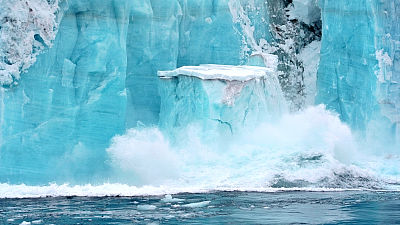Size of ice lumps of the size of Delaware separated from Antarctic Lashen ice shelves

The crack that entered the Larsen C shelf ice which is the fourth largest shelf ice in Antarctica is enormous, and from this long ago that it is highly probable that Larsen C collapses within several years due to this crackIt was reported. However, the latest research published on January 6, 2017 suggested that separation could occur within a few months.
Giant Antarctic iceberg set to break away, say Swansea researchers
http://www.swansea.ac.uk/media-centre/latest-research/giantantarcticicebergsettobreakawaysayswansearesearchers.php

Antarctica's Larsen C ice shelf may slide into the ocean - Business Insider
http://www.businessinsider.com/antarctica-giant-iceberg-breaking-off-2017-1
It has been confirmed that a mass of ice of the size of America / Delaware at the tip of Larsen C shelf ice is about to get away from Antarctica.
As snow is piled up, separation of ice chunks from shelf ice is possible, as it is normal even though the ice of the old glacier is pushed out into the sea. However, this time I am about to leave the shelf ice is a huge mass with a thickness of 335 meters or more and an area of approximately 5180 square kilometers. Moreover, the progress of separation is very fast, and the speed is seen as accelerating by global warming. In August 2016, it was said that "the possibility of collapse within a few years is great", but as a result of the latest survey it is expected to collapse as soon as a few months.
By the observation from the satellite it was around 2010 that the Larsen C shelf ice was found to have cracks, and in 2015 the length grew to 29 kilometers and in March 2016 observations an additional 22 kilometers It was told that it became long.
The figure below shows how cracks have grown.

Adrian Luckman, glaciologist at Swansea University in the UK who announced the survey, said, "I am surprised if separation of ice shelves does not occur in the coming months, the date of separation is quite close and inevitable," It is.
Meanwhile, NASA reports that in November 2016, Larsen C shelf ice cracks are 113 kilometers long, the width is 91 meters, and the crack depth is 540 meters. The results differ depending on the survey group because NASA's Earth Observation Satellite "which measured the thickness of the ice sheets and sea ice in polar regions and collected basic data to estimate the impact of global warming"ICESat"Has reached its end of life in 2009 and will be the successorICESat-2Because it can not be launched until 2018. As of 2017 NASA observes the crack of Larsen C shelf ice by the program called Operation Ice Bridge which observes the movement of ice on the earth using aircraft and other research team also actually flew over the shelf ice Because we are observing cracks, the prediction differs depending on the team. In addition, Mr. Donald Trump of the 45th president of the United States of America is saying that it is an idea to reduce NASA's research expenses.
Joe MacGregor, a geophysicist at the Goddard Space Flight Center, said, "Since there are not so many opportunities for us to study because huge cracks are hardly born so much," Larsen shelf ice separation is "one month, It is predicted that it will occur within 1 year. "The more you investigate these cracks, the more accurate you can predict the growth of cracks and how much separation of shelf ice will have the maximum impact on the ice sheet and ocean. In 2016 it was considered "within a few years", but separation seems to occur faster than expected at that time.

It is said that this separation will be the third largest in history. "Once a mass of ice flows out to the Weddell Sea or the Antarctic Ocean, it will eventually get caught up in the ocean circulation and melt, considering the size of the ice chunks, this process will take at least a few months," said MacGregor . Also,Research using computer modelingIt is indicated that this separation may destabilize the entire Larsen C ice shelf as large as about 50,000 square kilometers. MacGregor, however, is negative to this forecast.
Even if the ice chunks that are currently separating will ultimately melt in the ocean, there will be no effect on the sea level, but if the entire Larsen C ice shelves collapse, the sea level will be 4 inches (about 10 cm) It is seen as rising.
Related Posts:
in Science, Posted by darkhorse_log







